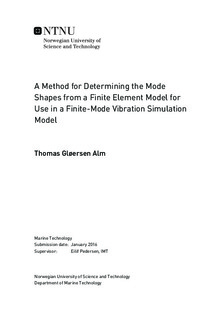| dc.description.abstract | In this thesis, a methodology for retrieving mathematical expressions of the mode shapes of a crankshaft based on numerical data yielded by a finite element model is presented and tested. The mode functions should be used as inputs to a finite-mode bond graph model of a crankshaft.
The contents and results of two papers related to torsional vibration modelling and simulation were presented, and their relevancy to this work was briefly discussed. A relevant section from a book on bond graph modelling was also presented. This section described an approach called finite-mode bond graph modelling, in which a continuous dynamic system is reduced to a modal representation. In order for this approach to work, the mode shapes of the system must be orthogonal.
A finite-mode IC-field bond graph representation of the crankshaft and crank mechanism were made using the Lagrange-Hamiltonian approach. However, this bond graph required the value of the mode shapes at the locations of torque input. These mode shapes were to be obtained from finite element models.
Models of a simple shaft and a single crank throw were made in the finite element software Abaqus. To check that the models were made correctly and to gain some experience with the software, the inertia and stiffness parameters were also retrieved. They were found to match their analytical counterparts well.
A frequency analysis was conducted in order to obtain the natural frequencies and corresponding mode shapes. The modal displacements at different locations along the axial direction were exported into a spreadsheet and plotted. From these numerical values, a set three of equations were set up to obtain a mathematical expression for each mode shape.
First a verification of the methodology was conducted on the simple shaft, as its analytical mode shapes and natural frequencies are well-known. The method worked well for this simple model. The resulting mathematical expressions for each mode shape were very close to the analytical form.
For the single crank throw, the overall shape of the numerical mode shapes and their corresponding mathematical expressions matched well. However, there was a large spread between the displacement values. Moreover, the obtained mathematical mode shapes were non-orthogonal, which meant that they couldn't be used in the finite-mode bond graph model of the crankshaft.
Another attempt was made at probing a different set of nodes from which the mathematical mode shape expressions could be obtained, but the resulting mode shape expressions still turned out to be non-orthogonal.
It might be possible that the mathematical mode shape expressions could fit the numerical points better if more than three equations were used. However, the problem could also be the manner in which the numerical values are obtained from the finite element model.
No simulations were run on the bond graph model. If a method is found to obtain orthogonal mode shapes for the crankshaft, the bond graph can get its required inputs. Simulations should then be run to verify its validity. The model could also be connected to existing models of a marine propulsion system. | |

